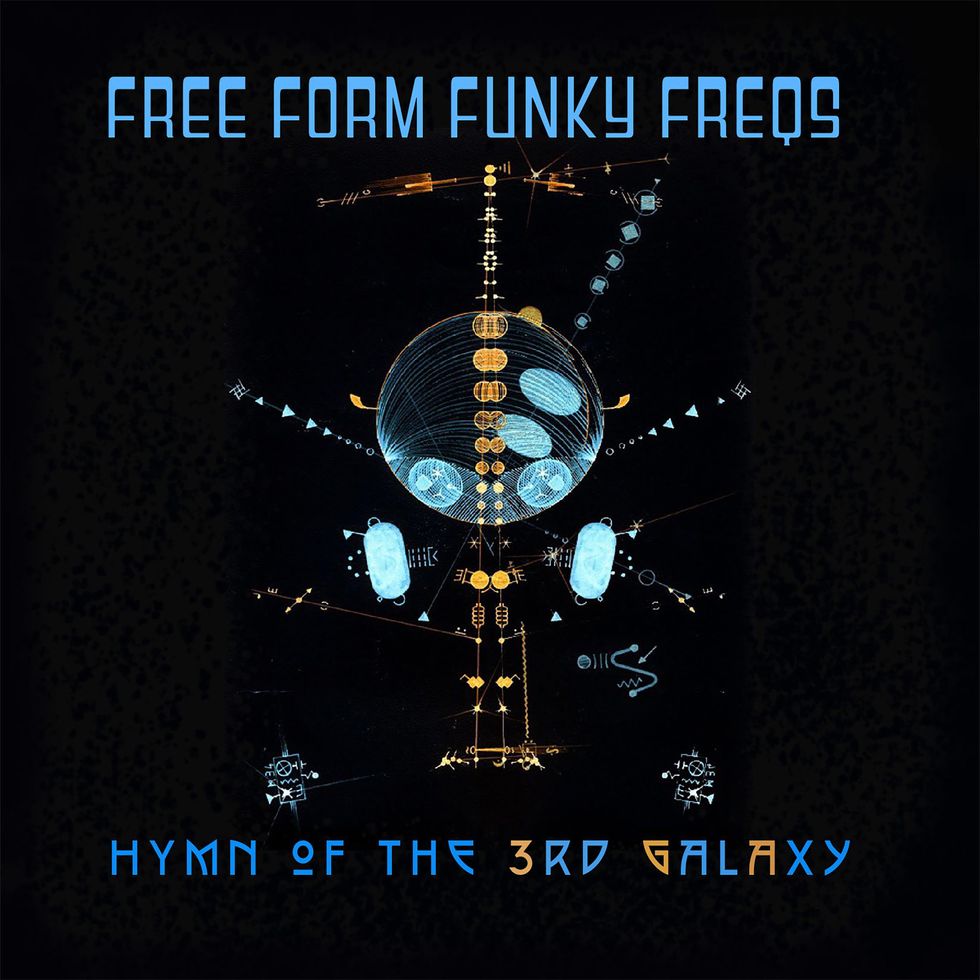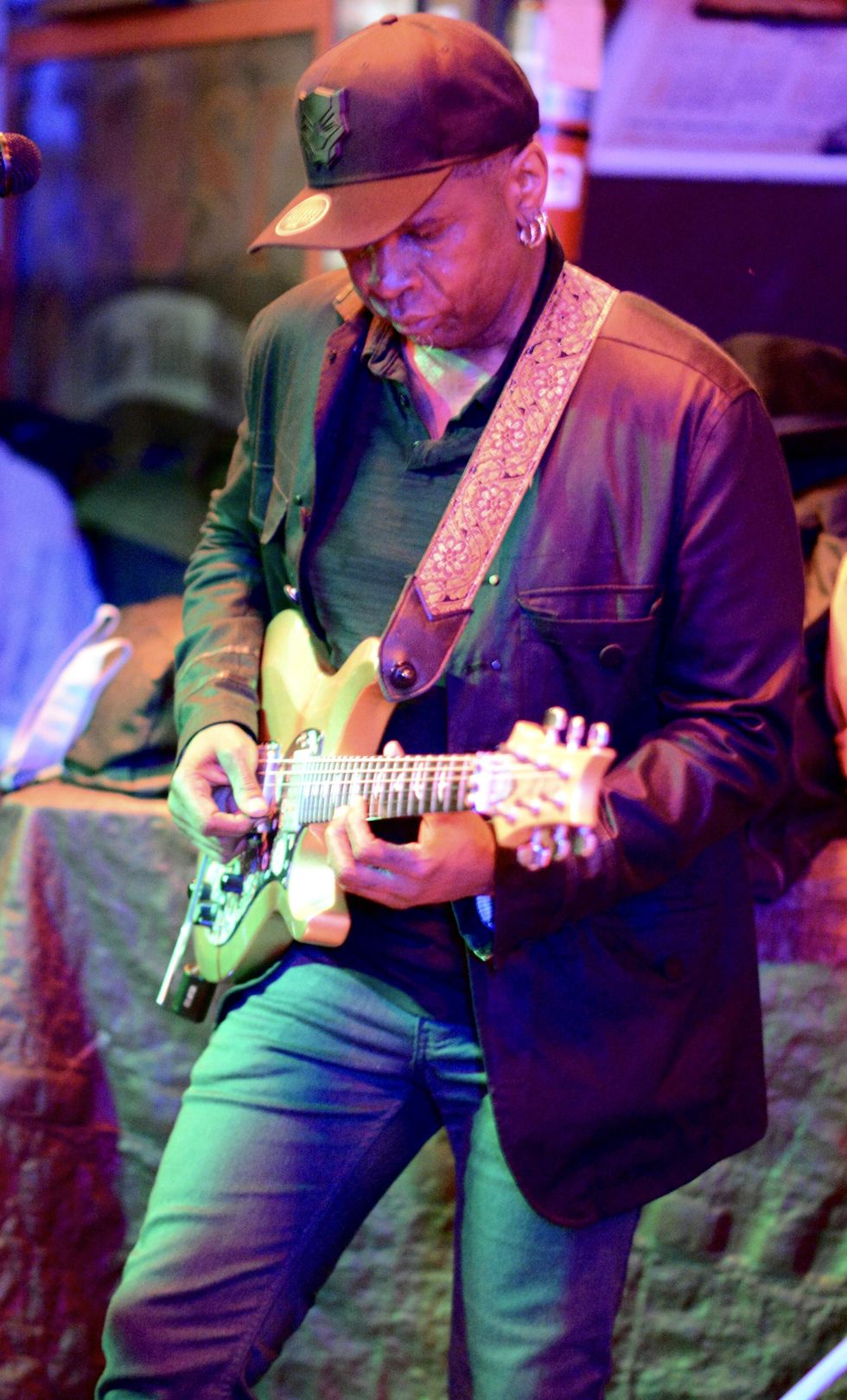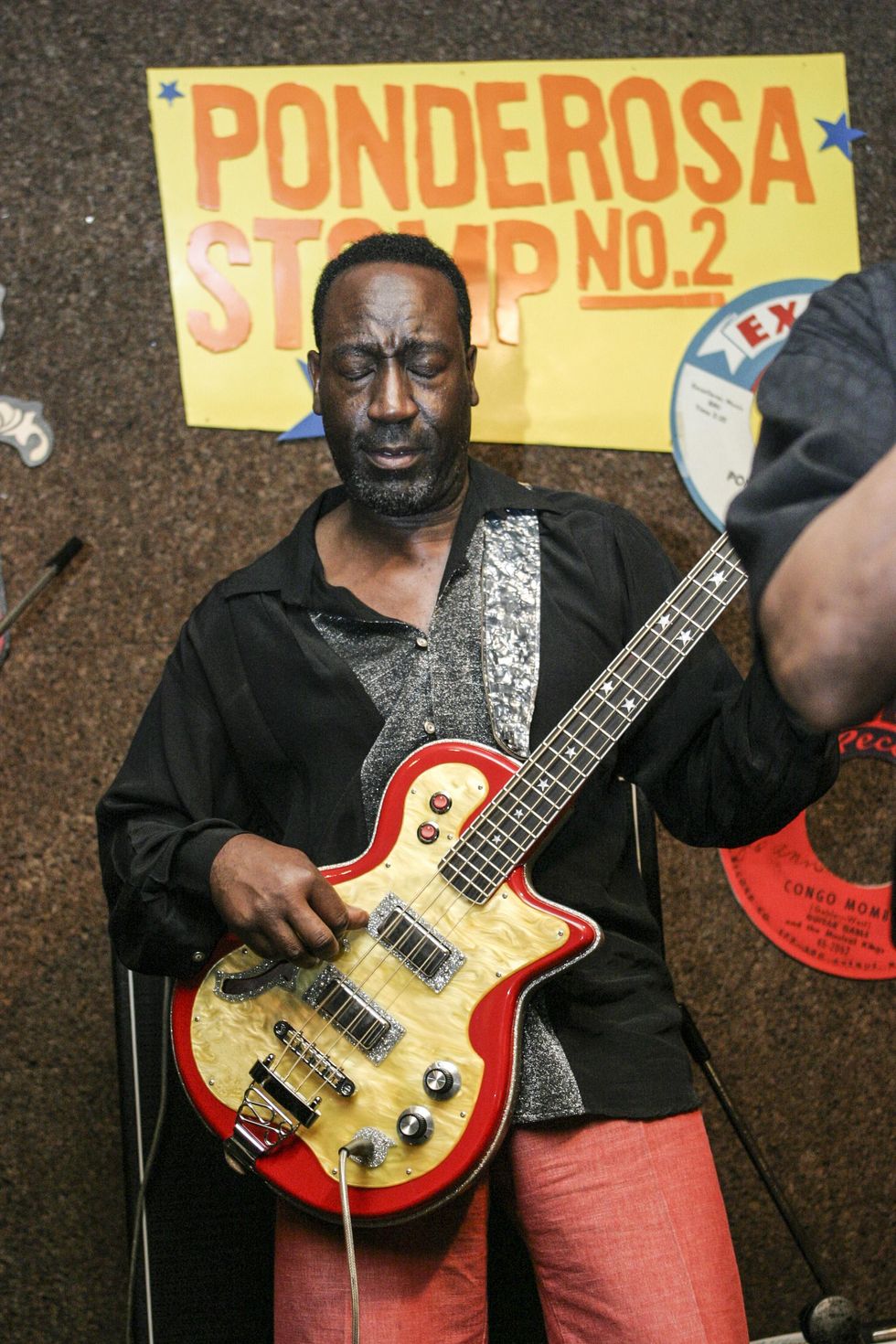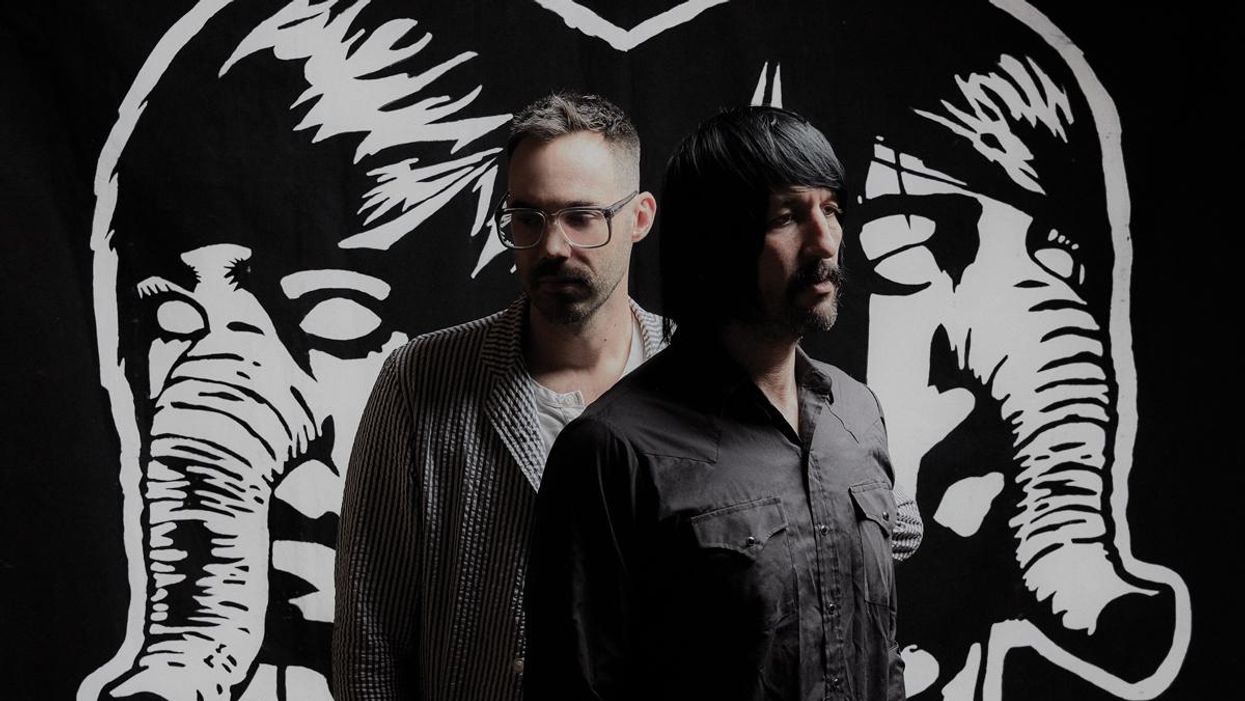How many bands can pinpoint the exact number of times they’ve played together? “It’s rare,” acknowledges guitarist Vernon Reid of Free Form Funky Freqs, the power trio he co-leads with bassist Jamaaladeen Tacuma and drummer G. Calvin Weston. Because “Free Form” is meant quite seriously—not a note of the music is planned in advance—every Freqs performance is a wholly unrepeatable event with its own distinct marker. This includes the three FFFF studio albums to date. The just-released Hymn of the 3rd Galaxy was performance number 73. Urban Mythology, Vol. 1, the band’s 2008 debut, was number three, after kickoff gigs at Tonic in New York and Tritone in Philadelphia (both defunct). Bon Vivant, the 2013 sophomore release, was number 15.
Owing to pandemic isolation, however, Hymn of the 3rd Galaxy was the first FFFF project to unfold asynchronously. First, Weston laid down his drums. Tacuma responded on bass. Reid brought up the rear with a pair of signature model Paul Reed Smiths and an abundance of digital and analog stompboxes, amp modelers, guitar synth floor units, and laptop-driven software synthesizers. There were no rules, save for this ironclad dictum: one uninterrupted take per track, no fixes, no overdubs. If it’s not “an organic improvised scenario,” in Tacuma’s words, it’s not Free Form Funky Freqs. It’s something else.
“I always dig an amp that’s gonna shake the room.” —Jamaaladeen Tacuma
“I just closed my eyes and pretended I was onstage with those guys,” Tacuma recalls. “The key was to keep the integrity of our process,” says Reid. “It was kind of like a self-imposed honor system.” This is, after all, a band that makes a point of not soundchecking together at gigs. “We have to explain this to house engineers,” Reid continues. “We’ll get sounds, then maybe check bass and drums, then guitar and drums. But we make it clear that the three of us are going to play only when it’s actually time to play.” To do otherwise would corrupt the method.

While their previous albums were live shows, the new FFFF opus was improvised in the studio—one artist at a time!
This improvisational purism makes sense given the band members’ overlapping histories in what Reid calls “the loose circle around Ornette Coleman.” The legendary alto saxophonist and free-jazz pioneer hired Tacuma for his groove-oriented ’70s band Prime Time, when the bassist was only 19. He later hired Weston, as well, at 17. “I was playing with [founding Prime Time drummer] Ronald Shannon Jackson,” adds Reid. “Calvin had played with Blood [experimental blues guitarist/singer James ‘Blood’ Ulmer].” There was a shared vein of experience in the contemporary avant-garde, and yet, as Tacuma observed to Reid one night, the three had never played together as a unit.
“We have to explain this to house engineers. We’ll get sounds, then maybe check bass and drums, then guitar and drums. But we make it clear that the three of us are going to play only when it’s actually time to play.” —Vernon Reid
Reid, of course, had also ascended to rock stardom with Living Colour in the late ’80s and cofounded the innovative Black Rock Coalition. For decades, each one of the Freqs had straddled genres and blown open the conversation about creative music in their time. It was practically fated for this band to form.
Vernon Reid’s Gear

Vernon Reid freqs-out on one of his PRS Custom Signature S2 Velas.
Photo by Sound Evidence
Guitars
- Two Paul Reed Smith Custom Vernon Reid Signature S2 Velas (one with EMGs, one with DS pickups)
- 1958 Gibson ES-345 (on “Earth”)
Amps
- Line 6 Helix
- Kemper Profiler
Strings & Picks
- D’Addario NYXLs (.011–.049)
- Dunlop 205s, Brass TeckPicks, V-Picks
- Graph Tech TUSQ 2.0 mm (“It’s kind of a fetish,” Reid says of his fascination with picks.)
Effects
- Moog MF-107 FreqBox
- Red Panda Tensor
- DigiTech Space Station
- Eventide H9
- Chase Bliss Tonal Recall
- Chase Bliss Dark World
- Boss SY-300
- Roland GI-20 Guitar MIDI Interface
- Spectrasonics Omnisphere software synth
- Arturia Pigments software synth
Studio production for FFFF has been divvied up evenly: Reid produced Urban Mythology, Vol. 1, Tacuma took the helm on Bon Vivant, and Weston brought the remote recording of Hymn of the 3rd Galaxy across the finish line. Each album bears the imprint of its producer in some way.
Weston named the new album and the individual tracks as well, and the meaning of it all becomes clear when you pull up a map of the Milky Way (one of three galaxies, along with Andromeda and Triangulum, that dominates what is known as the Local Group). “Near Arm,” “Outer Arm,” “Norma Arm,” “Perseus Arm,” “Sagittarius Arm,” “Orion Spur,” “Scutum Centaurus,” “Far 3 kpc”—these are names that astronomers have given to the Milky Way’s various regions. In this environment, “Earth” and “Sun” (two more track titles) are just infinitesimally small dots.
“Bill Connors’ playing is so full of fire, but it’s also emotionally vulnerable in a way.” —Vernon Reid
The album title is also a conscious reference to Return to Forever’s 1973 album Hymn of the Seventh Galaxy—the fusion supergroup’s one recording to feature guitarist Bill Connors. “That record was very important in my development,” says Reid. “Bill Connors’ playing on it is so full of fire, but it’s also emotionally vulnerable in a way. I was very affected by the compositions, as well. When Calvin mentioned the title, it put this project into a frame for me—the idea of spatial ambience—and that did affect my choices for sounds.”
Those sounds are an amalgam of raw, plugged-in lead guitar crunch and otherwordly sonic glitter: notes that start as notes but become starbursts, or decay like pyrotechnic embers; chordal shapes that overlap and gather into big nebulous clouds. With his seemingly limitless tech-heavy rig, Reid has all frequencies covered.
Jamaaladeen Tacuma’s Gear

Jamaaladeen Tacuma brings his epic funk at the 2003 Ponderosa Stomp festival in New Orleans, where he performed with James “Blood” Ulmer and FFFF drummer Calvin Weston.
Photo by Joseph A. Rosen
Effects
- Korg ToneWorks G5 Synth Bass Processor
- JAM Wahcko
- JAM WaterFall
- JAM LucyDreamer
Strings
- La Bella various-gauge sets
The groove is just as essential, and Tacuma and Weston know how to bring it, whether it’s a slow shuffle (“Perseus Arm”), a mid-tempo Meters-like vibe (“Norma Arm”), or an outbreak of fast, full-tilt abstraction (“Far 3 kpc,” “Sun”). Regardless of feel, Tacuma’s criterion for a bass sound is straightforward: “I always dig an amp that’s gonna shake the room. I mean, I need that room-shaker. Coming up in Philly, hearing R&B groups at the Uptown Theater, which was like the Apollo, as long as that bass was shakin’ the room, that was the most important thing. Aguilar has proven to be a wonderful addition to my setup for the clarity and punchiness, and the ability to dial in certain sounds that I want.” Holding up the Korg Toneworks G5 synth-bass unit that he used on Hymn, during our Zoom call, he adds: “I’m not really a pedal guy, but now and then I’ll bring one out for a special black-tie occasion.”
Ultimately, what explains FFFF’s ability to create together on the fly is musical intelligence and empathetic listening. When Reid’s guitar is more enveloping and spacious and legato, Tacuma’s playing might get busier, and vice versa. “If you go outside right now,” Tacuma observes, “somebody’s walking, somebody’s running. Somebody’s listening, somebody’s talking. Somebody’s eating, somebody’s drinking. All these things are happening, and with music it’s the same thing.” For Reid, as well, deciding when to go for maximum synthesized mayhem (“Galactic Bar”) or a cleaner, more identifiably guitaristic tone (“Earth”) is a matter of attending to the moment. “It’s different than dealing with songs that have a verse-chorus-bridge,” he says. “This is a whole different kind of flow.”
“I’m not really a pedal guy, but now and then I’ll bring one out for a special black-tie occasion.” —Jamaaladeen Tacuma
When discussion turns to Tacuma’s other projects, such as his 2017 album Gnawa Soul Experience, the bassist suggests a link between the FFFF worldview and the time he shared with ethnic Gnawa musicians in Essaouira, Morocco. “Musically, I learned so much,” he recalls. “When they play all night and they don’t have anything written in front of them, and they’re just grooving and going higher and higher in the music, that’s basically what we do, when you put it in perspective. People relate to that; they can understand that.”
With every Freqs encounter, the three bring new elements and ideas they’ve absorbed in the interim, and this keeps the music fresh and evolving. Tacuma and Weston continue to nourish their local Philly scene, mentoring and giving exposure to younger players. Tacuma’s annual Outsiders Improvised & Creative Music Festival always provides a burst of energy. Living Colour is still percolating since the release of Shade, its sixth album, in 2017. Meanwhile Reid has kept additional irons in the fire, including the Zig Zag Power Trio (with bassist Melvin Gibbs and Living Colour drummer Will Calhoun) and other projects. If he, Tacuma, and Weston keep up the pace, they could soon hit the big 100—the Freqs’ centenary performance. Stay tuned for that album.Free Form Funky Freqs Live | Ch0 | 2012
All hail the groove! Sure, this 2012, Ljubljana, Slovenia, performance by Vernon Reid, Jamaaladeen Tacuma, and Calvin Weston is freaky … but the funky vibe dictates the flow of its ambient sounds. Catch Tacuma freestyling on the mic at 4:00.






![Rig Rundown: AFI [2025]](https://www.premierguitar.com/media-library/youtube.jpg?id=62064741&width=1245&height=700&quality=70&coordinates=0%2C0%2C0%2C0)












 Shop Scott's Rig
Shop Scott's Rig













 Zach loves his Sovtek Mig 60 head, which he plays through a cab he built himself at a pipe-organ shop in Denver. Every glue joint is lined with thin leather for maximum air tightness, and it’s stocked with Celestion G12M Greenback speakers.
Zach loves his Sovtek Mig 60 head, which he plays through a cab he built himself at a pipe-organ shop in Denver. Every glue joint is lined with thin leather for maximum air tightness, and it’s stocked with Celestion G12M Greenback speakers.












![Devon Eisenbarger [Katy Perry] Rig Rundown](https://www.premierguitar.com/media-library/youtube.jpg?id=61774583&width=1245&height=700&quality=70&coordinates=0%2C0%2C0%2C0)








 Luis Munoz makes the catch.
Luis Munoz makes the catch.


